

Compact Muon Solenoid
LHC, CERN
| CMS-PAS-EXO-20-001 | ||
| Search for W$ \gamma $ resonances using hadronic decays of Lorentz-boosted W bosons in proton-proton collisions at $\sqrt{s} = $ 13 TeV | ||
| CMS Collaboration | ||
| March 2021 | ||
| Abstract: A search for W$ \gamma $ resonances in the mass range between 700 and 6000 GeV is presented. The W boson is reconstructed via its hadronic decay, with the final-state products forming a single, large-radius jet, owing to a large Lorentz boost of the W boson. The search is based on proton-proton collision data at $\sqrt{s} = $ 13 TeV, collected with the CMS detector in 2016-2018, corresponding to an integrated luminosity of 137 fb$^{-1}$. The W$ \gamma $ invariant mass spectrum is parameterized with a smoothly falling background function and examined for the presence of resonance-like signals. No significant excesses above the predicted background are observed. Model-specific limits at 95% confidence level on the production cross section times branching fraction to the W$ \gamma $ channel are set for narrow resonances and for resonances with an intrinsic width equal to 5% of their mass, for spin-0 and spin-1 hypotheses, ranging between 0.11 and 35 fb. These are the most restrictive limits to date on the existence of such resonances. Model-independent limits on the production cross section times branching fraction to the W$ \gamma $ channel times signal acceptance are also set for minimum W$ \gamma $ mass thresholds between 1500 and 8000 GeV, allowing for testing more general models predicting production of a photon in association with a jet consistent with a hadronic W or Z boson decay. | ||
|
Links:
CDS record (PDF) ;
CADI line (restricted) ;
These preliminary results are superseded in this paper, Submitted to PLB. The superseded preliminary plots can be found here. |
||
| Figures | |

png pdf |
Figure 1:
Definitions of the signal and control region in data, based on the jet mass ${m_\mathrm {J}^\text {SD}}$. The stacked filled histograms represent dominant backgrounds from simulation, normalized to the $ {p_{\text {T}}^{\gamma}} $ spectrum in the signal region. Red (black) points correspond to data in the signal (control) region. Benchmark spin-0 signal distributions, normalized to a cross section of 2 pb, for two mass (1 and 3.5 TeV) and two width (narrow, N, and broad, B) hypotheses are shown with dashed lines. The two lower panels show the data-to-simulation ratio in the control and signal regions. |

png pdf |
Figure 2:
Distribution of some of the kinematic variables used in the analysis. Upper row: $ {p_{\text {T}}^{\gamma}} $ (left), ${m_{{\mathrm {J}\gamma}}}$ (right); middle row: $ {\eta _\mathrm {J}} $ (left), $\cos^*\theta _\gamma $ (right); lower row: $ {p_{\text {T}}^{\gamma}} / {m_{{\mathrm {J}\gamma}}} $ (left), ${\tau _{21}}$ (right). The notations are the same as in Fig. 1, except that the yield in the control region is normalized to that in the signal region. The discrepancy seen in the ${\tau _{21}}$ variable in the control region and either signal region or simulation is due to the correlation of the $N$-subjettiness variable with the jet mass. The control region data are therefore not used in the optimization of the ${\tau _{21}}$ selection. |

png pdf |
Figure 2-a:
Distribution of the $ {p_{\text {T}}^{\gamma}} $ kinematic variable.The notations are the same as in Fig. 1, except that the yield in the control region is normalized to that in the signal region. |
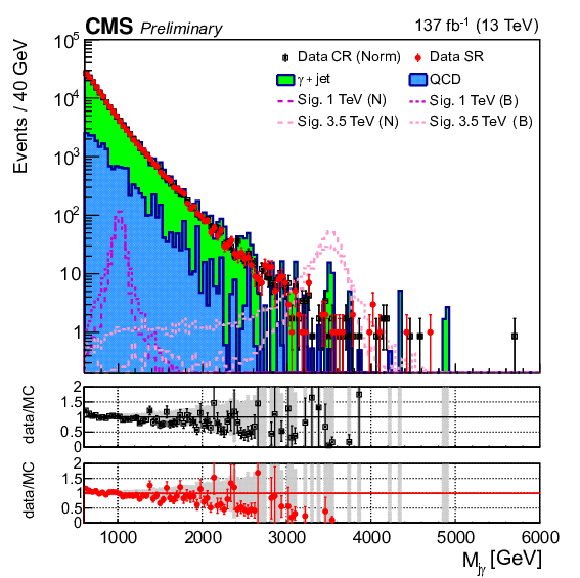
png pdf |
Figure 2-b:
Distribution of the ${m_{{\mathrm {J}\gamma}}}$ kinematic variable. The notations are the same as in Fig. 1, except that the yield in the control region is normalized to that in the signal region. |

png pdf |
Figure 2-c:
Distribution of the $ {\eta _\mathrm {J}} $ kinematic variable.The notations are the same as in Fig. 1, except that the yield in the control region is normalized to that in the signal region. |

png pdf |
Figure 2-d:
Distribution of the $\cos^*\theta _\gamma $ kinematic variable.The notations are the same as in Fig. 1, except that the yield in the control region is normalized to that in the signal region. |
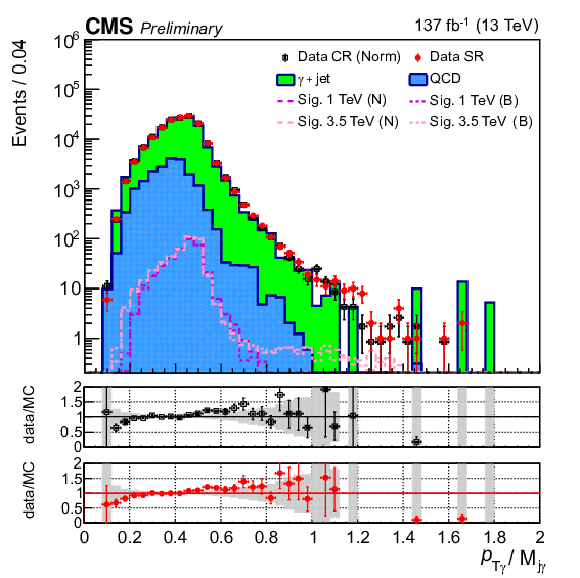
png pdf |
Figure 2-e:
Distribution of the $ {p_{\text {T}}^{\gamma}} / {m_{{\mathrm {J}\gamma}}} $ kinematic variable.The notations are the same as in Fig. 1, except that the yield in the control region is normalized to that in the signal region. |
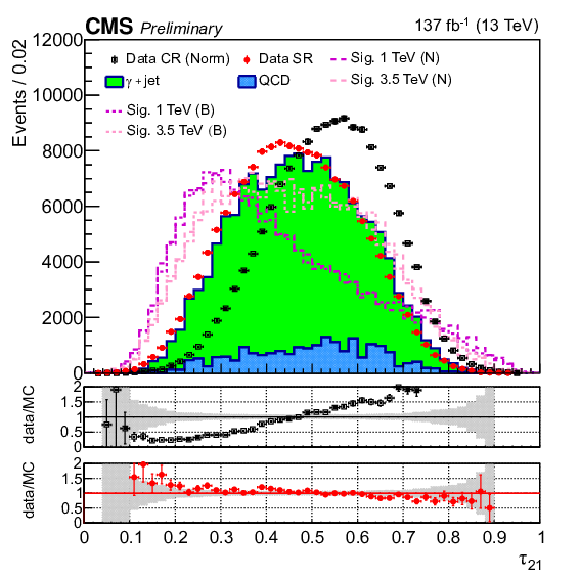
png pdf |
Figure 2-f:
Distribution of the ${\tau _{21}}$ kinematic variable. The notations are the same as in Fig. 1, except that the yield in the control region is normalized to that in the signal region. The discrepancy seen in the control region and either signal region or simulation is due to the correlation of the $N$-subjettiness variable with the jet mass. The control region data are therefore not used in the optimization of the ${\tau _{21}}$ selection. |

png pdf |
Figure 3:
Signal acceptance ${\cal A}$ (upper left), the product of signal acceptance and selection efficiency ${\cal A}\varepsilon $ (upper right), and W tagging efficiency (lower) for spin-0 (solid lines) and spin-1 (dashed lines) resonances, for the narrow (red) and broad (blue) hypotheses. The curves are obtained by fitting the set of discrete mass points, for which simulated signal samples are available, with fourth-order polynomials. For the W tagging efficiency, also shown is an average value obtained for the different spin and width hypotheses (the green curve with the hatched uncertainty band). |

png pdf |
Figure 3-a:
Signal acceptance ${\cal A}$ for spin-0 (solid lines) and spin-1 (dashed lines) resonances, for the narrow (red) and broad (blue) hypotheses. The curves are obtained by fitting the set of discrete mass points, for which simulated signal samples are available, with fourth-order polynomials. Figure 3-b |
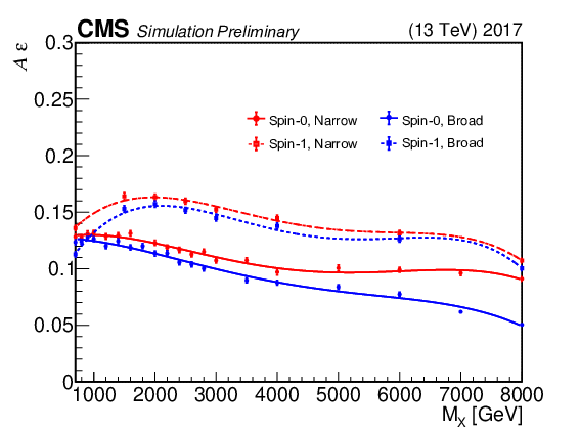
png pdf |
Figure 3-b:
Signal acceptance ${\cal A}$ (upper left), the product of signal acceptance and selection efficiency ${\cal A}\varepsilon $ (upper right), and W tagging efficiency (lower) for spin-0 (solid lines) and spin-1 (dashed lines) resonances, for the narrow (red) and broad (blue) hypotheses. The curves are obtained by fitting the set of discrete mass points, for which simulated signal samples are available, with fourth-order polynomials. For the W tagging efficiency, also shown is an average value obtained for the different spin and width hypotheses (the green curve with the hatched uncertainty band). |

png pdf |
Figure 3-c:
W tagging efficiency for spin-0 (solid lines) and spin-1 (dashed lines) resonances, for the narrow (red) and broad (blue) hypotheses. The curves are obtained by fitting the set of discrete mass points, for which simulated signal samples are available, with fourth-order polynomials. Also shown is an average value obtained for the different spin and width hypotheses (the green curve with the hatched uncertainty band). |

png pdf |
Figure 4:
Background-only fit to data (black points) with the chosen background function. The green and yellow bands show, respectively, the 68 and 95% confidence level statistical uncertainties in the fit. The lower panel contains the pull distribution, defined as the difference between the data yield and the background prediction, divided by the combined uncertainty in both. Expected signal shapes are also shown in the lower panel for three different resonance mass hypotheses, 1000 GeV (red), 2600 GeV (cyan), and 4000 GeV (green) and for both narrow (solid) and broad (dashed) cases. Signal normalizations are set to 15, 1, and 0.3 fb, respectively, for illustration purpose. In the limit setting procedure, the optimal values of the background parameters are refitted for each signal mass hypothesis to account for the uncertainties associated with the background prediction. |

png pdf |
Figure 5:
Expected and observed 95% CL limits on $\sigma {\cal B}(X \rightarrow \mathrm{W} \gamma)$ for the spin-0 (upper row) and spin-1 (lower row) resonances for the narrow (left column) and broad (right column) resonance cases. |

png pdf |
Figure 5-a:
Expected and observed 95% CL limits on $\sigma {\cal B}(X \rightarrow \mathrm{W} \gamma)$ for the spin-0 resonances for the narrow resonance cases. |

png pdf |
Figure 5-b:
Expected and observed 95% CL limits on $\sigma {\cal B}(X \rightarrow \mathrm{W} \gamma)$ for the spin-0 resonances for the broad resonance cases. |

png pdf |
Figure 5-c:
Expected and observed 95% CL limits on $\sigma {\cal B}(X \rightarrow \mathrm{W} \gamma)$ for the spin-1 resonances for the narrow resonance cases. |

png pdf |
Figure 5-d:
Expected and observed 95% CL limits on $\sigma {\cal B}(X \rightarrow \mathrm{W} \gamma)$ for the spin-1 resonances for the broad resonance cases. |
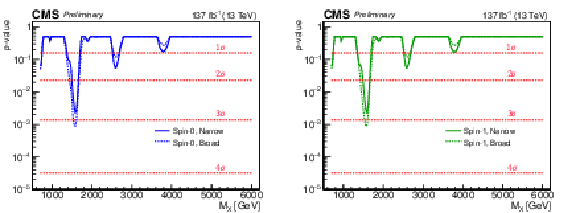
png pdf |
Figure 6:
Observed background-only fit $p$-values for spin-0 (left) and spin-1 (right) resonance hypotheses. The largest excess observed at 1580 GeV, corresponds to a local significance of 2.8 (3.1) standard deviations ($\sigma $) for narrow (broad) signals, for both spin hypotheses. |
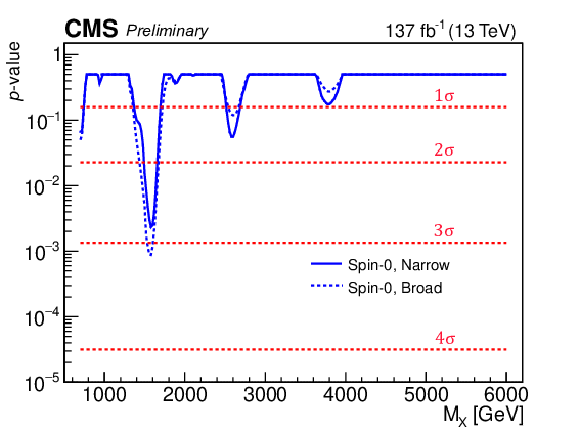
png pdf |
Figure 6-a:
Observed background-only fit $p$-values for the spin-0 resonance hypothesis. The largest excess observed at 1580 GeV, corresponds to a local significance of 2.8 (3.1) standard deviations ($\sigma $) for narrow (broad) signals. |

png pdf |
Figure 6-b:
Observed background-only fit $p$-values for the spin-1 resonance hypothesis. The largest excess observed at 1580 GeV, corresponds to a local significance of 2.8 (3.1) standard deviations ($\sigma $) for narrow (broad) signals. |

png pdf |
Figure 7:
Expected and observed 95% CL model-independent limits on $\sigma {\cal B}(X \rightarrow \mathrm{W} \gamma) {\cal A}$ (left) and $\sigma {\cal B}(X \rightarrow \mathrm{W} \gamma) {\cal A} \epsilon _{\rm W tag}$ (right), as a function of the minimum invariant mass requirement on the ${\mathrm {J}\gamma}$ system. |
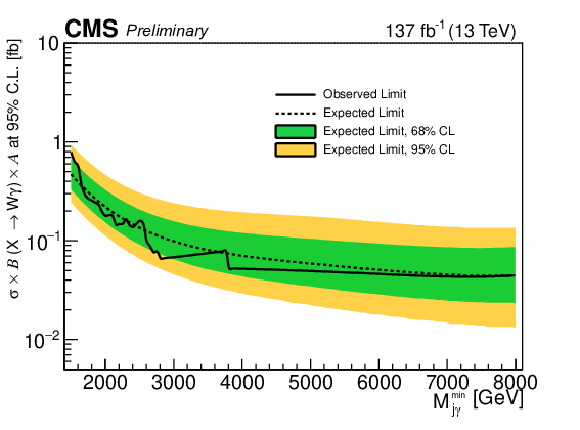
png pdf |
Figure 7-a:
Expected and observed 95% CL model-independent limits on $\sigma {\cal B}(X \rightarrow \mathrm{W} \gamma) {\cal A}$, as a function of the minimum invariant mass requirement on the ${\mathrm {J}\gamma}$ system. |

png pdf |
Figure 7-b:
Expected and observed 95% CL model-independent limits on $\sigma {\cal B}(X \rightarrow \mathrm{W} \gamma) {\cal A} \epsilon _{\rm W tag}$, as a function of the minimum invariant mass requirement on the ${\mathrm {J}\gamma}$ system. |
| Tables | |

png pdf |
Table 1:
Systematic uncertainties affecting the signal description. Uncertainties marked with the dagger affect both the yield and the shape of the signal distribution, while the rest only affect the signal yield. In case the uncertainty is different for various data taking periods, the three numbers given in the second column correspond to the 2016/2017/2018 data taking, while the third column shows the combined uncertainties across the three years, taking into account the year-to-year correlations. The effect on the signal yield is the same for all the hypotheses studied. |
| Summary |
| In summary, a search for W$ \gamma $ resonances in the mass range between 700 and 6000 GeV has been presented. The W boson is reconstructed via its hadronic decay, with the final-state products forming a single, large-radius jet, owing to a large Lorentz boost of the W boson. The search is based on the proton-proton collision data at $\sqrt{s} = $ 13 TeV, collected with the CMS detector in 2016-2018, corresponding to an integrated luminosity of 137 fb$^{-1}$. No significant excesses above the smoothly falling background is observed. Limits at 95% confidence level on the production cross section times branching fraction for W$ \gamma $ resonances are set for narrow and broad (with the intrinsic width equal 5% of their mass) resonances, ranging from 21 (32) fb to 0.15 (0.23) fb for the narrow (broad) spin-0 hypothesis, and from 20 (35) fb to 0.11 (0.13) fb for the spin-1 hypotheses. The results reported are the most restrictive limits to date on the existence of such resonances. In addition, model-independent limits are also set on the production cross section times branching fraction times signal acceptance, as a function of the minimum invariant mass of the jet-photon system, offering a possibility to interpret these results in the context of other models predicting similar signatures. |
| References | ||||
| 1 | ATLAS Collaboration | Observation of a new particle in the search for the Standard Model Higgs boson with the ATLAS detector at the LHC | PLB 716 (2012) 1 | 1207.7214 |
| 2 | CMS Collaboration | Observation of a new boson at a mass of 125 GeV with the CMS experiment at the LHC | PLB 716 (2012) 30 | CMS-HIG-12-028 1207.7235 |
| 3 | CMS Collaboration | Observation of a new boson with mass near 125 GeV in pp collisions at $ \sqrt{s} = $ 7 and 8 TeV | JHEP 06 (2013) 081 | CMS-HIG-12-036 1303.4571 |
| 4 | ATLAS Collaboration | Measurements of $ W \gamma $ and $ Z \gamma $ production in pp collisions at $ \sqrt{s} = $ 7 TeV with the ATLAS detector at the LHC | PRD 87 (2013) 112003 | 1302.1283 |
| 5 | ATLAS Collaboration | Search for new resonances in $ W\gamma $ and $ Z\gamma $ final states in pp collisions at $ \sqrt s= $ 8 TeV with the ATLAS detector | PLB 738 (2014) 428 | 1407.8150 |
| 6 | ATLAS Collaboration | Search for heavy resonances decaying to a photon and a hadronically decaying Z/W/H boson in pp collisions at $ \sqrt{s}= $ 13 TeV with the ATLAS detector | PRD 98 (2018) 032015 | 1805.01908 |
| 7 | G. Burdman et al. | The quirky collider signals of folded supersymmetry | PRD 78 (2008) 075028 | 0805.4667 |
| 8 | J. F. Gunion, H. E. Haber, G. L. Kane, and S. Dawson | The Higgs Hunter's Guide | volume 80 of Front. Phys Perseus Books | |
| 9 | M. Capdequi Peyranere, H. E. Haber, and P. Irulegui | $ H^\pm \to W^\pm\gamma $ and $ H^\pm \to W^\pm Z $ in two Higgs doublet models. 1. The large fermion mass limit | PRD 44 (1991) 191 | |
| 10 | J. F. Gunion, G. L. Kane, and J. Wudka | Search techniques for charged and neutral intermediate mass Higgs bosons | NPB 299 (1988) 231 | |
| 11 | S. Weinberg | Implications of Dynamical Symmetry Breaking | PRD 13 (1976) 974 | |
| 12 | L. Susskind | Dynamics of spontaneous symmetry breaking in the Weinberg--Salam theory | PRD 20 (1979) 2619 | |
| 13 | K. D. Lane and E. Eichten | Two scale technicolor | PLB 222 (1989) 274 | |
| 14 | E. Eichten and K. Lane | Low-scale technicolor at the Tevatron and LHC | PLB 669 (2008) 235 | 0706.2339 |
| 15 | D. Pappadopulo, A. Thamm, R. Torre, and A. Wulzer | Heavy vector triplets: Bridging theory and data | JHEP 09 (2014) 060 | 1402.4431 |
| 16 | K. Howe, S. Knapen, and D. J. Robinson | Diphotons from electroweak triplet-singlet mixing | PRD 94 (2016) 035021 | 1603.08932 |
| 17 | CMS Collaboration | The CMS trigger system | JINST 12 (2017) P01020 | CMS-TRG-12-001 1609.02366 |
| 18 | CMS Collaboration | The CMS experiment at the CERN LHC | JINST 3 (2008) S08004 | CMS-00-001 |
| 19 | N. Arkani-Hamed, R. T. D'Agnolo, M. Low, and D. Pinner | Unification and new particles at the LHC | JHEP 11 (2016) 082 | 1608.01675 |
| 20 | R. M. Capdevilla, R. Harnik, and A. Martin | The radiation valley and exotic resonances in $ W\gamma $ production at the LHC | JHEP 03 (2020) 117 | 1912.08234 |
| 21 | T. Sjostrand, S. Mrenna, and P. Z. Skands | A brief introduction to PYTHIA 8.1 | CPC 178 (2008) 852 | 0710.3820 |
| 22 | P. Skands, S. Carrazza, and J. Rojo | Tuning PYTHIA 8.1: the Monash 2013 tune | EPJC 74 (2014) 3024 | 1404.5630 |
| 23 | CMS Collaboration | Event generator tunes obtained from underlying event and multiparton scattering measurements | EPJC 76 (2016) 155 | CMS-GEN-14-001 1512.00815 |
| 24 | CMS Collaboration | Extraction and validation of a new set of CMS PYTHIA8 tunes from underlying-event measurements | EPJC 80 (2020) 4 | CMS-GEN-17-001 1903.12179 |
| 25 | NNPDF Collaboration | Parton distributions for the LHC Run II | JHEP 04 (2015) 040 | 1410.8849 |
| 26 | NNPDF Collaboration | Parton distributions from high-precision collider data | EPJC 77 (2017) 663 | 1706.00428 |
| 27 | GEANT4 Collaboration | GEANT4 --- a simulation toolkit | NIMA 506 (2003) 250 | |
| 28 | CMS Collaboration | Particle-flow reconstruction and global event description with the CMS detector | JINST 12 (2017) P10003 | CMS-PRF-14-001 1706.04965 |
| 29 | M. Cacciari, G. P. Salam, and G. Soyez | The anti-$ k_\text{t} $ jet clustering algorithm | JHEP 04 (2008) 063 | 0802.1189 |
| 30 | M. Cacciari, G. P. Salam, and G. Soyez | FastJet user manual | EPJC 72 (2012) 1896 | 1111.6097 |
| 31 | CMS Collaboration | Performance of photon reconstruction and identification with the CMS detector in proton-proton collisions at $ \sqrt{s} = $ 8 TeV | JINST 10 (2015) P08010 | CMS-EGM-14-001 1502.02702 |
| 32 | M. Cacciari and G. P. Salam | Pileup subtraction using jet areas | PLB 659 (2008) 119 | 0707.1378 |
| 33 | CMS Collaboration | Determination of jet energy calibration and transverse momentum resolution in CMS | JINST 6 (2011) P11002 | CMS-JME-10-011 1107.4277 |
| 34 | CMS Collaboration | Jet energy scale and resolution in the CMS experiment in pp collisions at 8 TeV | JINST 12 (2017) P02014 | CMS-JME-13-004 1607.03663 |
| 35 | CMS Collaboration | Jet algorithms performance in 13 TeV data | CMS-PAS-JME-16-003 | CMS-PAS-JME-16-003 |
| 36 | A. J. Larkoski, S. Marzani, G. Soyez, and J. Thaler | Soft drop | JHEP 05 (2014) 146 | 1402.2657 |
| 37 | CMS Collaboration | Search for a massive resonance decaying to a pair of Higgs bosons in the four b quark final state in proton-proton collisions at $ \sqrt{s}= $ 13 TeV | PLB 781 (2018) 244 | 1710.04960 |
| 38 | J. Thaler and K. Van Tilburg | Identifying boosted objects with $ N $-subjettiness | JHEP 03 (2011) 015 | 1011.2268 |
| 39 | M. J. Oreglia | A study of the reactions $\psi' \to \gamma\gamma \psi$ | PhD thesis, Stanford University, 1980 SLAC Report SLAC-R-236, see A | |
| 40 | A. L. Read | Linear interpolation of histograms | NIMA 425 (1999) 357 | |
| 41 | CMS Collaboration | CMS luminosity measurements for the 2016 data-taking period | CMS-PAS-LUM-17-001 | CMS-PAS-LUM-17-001 |
| 42 | CMS Collaboration | CMS luminosity measurements for the 2017 data-taking period at $ \sqrt{s} = $ 13 TeV | CMS-PAS-LUM-17-004 | CMS-PAS-LUM-17-004 |
| 43 | CMS Collaboration | CMS luminosity measurements for the 2018 data-taking period at $ \sqrt{s} = $ 13 TeV | CMS-PAS-LUM-18-002 | CMS-PAS-LUM-18-002 |
| 44 | CMS Collaboration | Measurement of the inelastic proton-proton cross section at $ \sqrt{s}= $ 13 TeV | JHEP 07 (2018) 161 | CMS-FSQ-15-005 1802.02613 |
| 45 | J. Butterworth et al. | PDF4LHC recommendations for LHC Run II | JPG 43 (2016) 023001 | 1510.03865 |
| 46 | CMS Collaboration | Identification techniques for highly boosted W bosons that decay into hadrons | JHEP 12 (2014) 017 | CMS-JME-13-006 1410.4227 |
| 47 | T. Junk | Confidence level computation for combining searches with small statistics | NIMA 434 (1999) 435 | hep-ex/9902006 |
| 48 | A. L. Read | Presentation of search results: the $ \mathrm{CL_s} $ technique | JPG 28 (2002) 2693 | |
| 49 | ATLAS and CMS Collaborations | Procedure for the LHC Higgs boson search combination in Summer 2011 | ATL-PHYS-PUB-2011-011, CMS NOTE-2011/005 | |
| 50 | G. Cowan, K. Cranmer, E. Gross, and O. Vitells | Asymptotic formulae for likelihood-based tests of new physics | EPJC 71 (2011) 1554 | 1007.1727 |
| 51 | E. Gross and O. Vitells | Trial factors or the look elsewhere effect in high energy physics | EPJC 70 (2010) 525 | 1005.1891 |

|
Compact Muon Solenoid LHC, CERN |

|

|

|

|

|

|